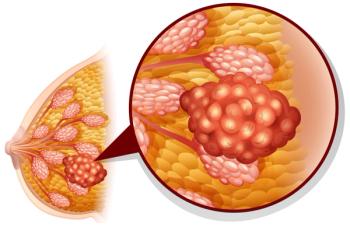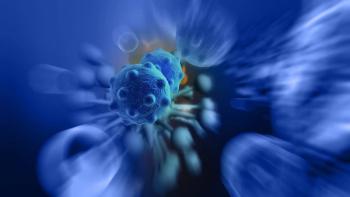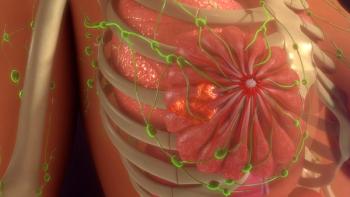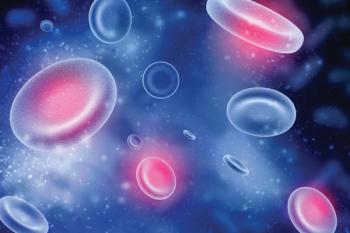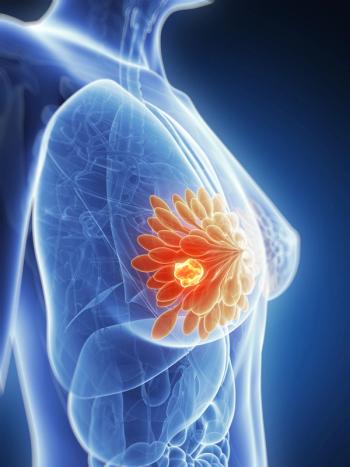
Talquetamab/Daratumumab Combo Yields Tolerable Toxicities, Promising Responses in Relapsed/Refractory Myeloma
Findings from the phase 1b TRIMM-2 study indicated that patients with relapsed/refractory multiple myeloma experienced manageable toxicities and promising responses to treatment with talquetamab and daratumumab.
The addition of talquetamab to daratumumab (Darzalex) yielded no overlapping toxicities and a tolerable safety profile, as well as promising responses in a population of patients with relapsed/refractory multiple myeloma, according to findings from the phase 1b TRIMM-2 study (NCT04108195) that were presented at the
After a median follow-up of 4.2 months, the 400 μg/kg dose of talquetamab (n = 5) every 2 weeks yielded an overall response rate (ORR) of 80.0%, the once weekly 400 μg/kg (n = 7) dose resulted in an ORR of 85.7%, and the 800 μg/kg (n = 9) dose resulted in an ORR of 77.8%. The median time to first confirmed response was 1.0 month (range, 0.9-2.4).
“The combination of talquetamab and daratumumab appears to be tolerable with no overlapping toxicity,” Ajai Chari, MD, a professor of medicine, hematology, and medical oncology at Mount Sinai, said during a presentation on the findings. “The safety profile was consistent with each agent given as a monotherapy and no new adverse [effects; AEs] were observed.”
In addition to the different doses of subcutaneous talquetamab, patients also received 1800 mg of subcutaneous daratumumab once weekly during cycles 1 and 2, twice weekly during cycles 3 through 6, and every month in cycle 7 and beyond.
To be eligible for the study, adult patients were required to have documented multiple myeloma diagnosis per International Myeloma Working Group criteria. They also required 3 or more previous lines of treatment or be double refractory to a proteasome inhibitor and an immunomodulatory drug. Patients were allowed to have received treatment with an anti-CD38 therapy within over 90 days prior to enrollment; this included patients who were refractory to an anti-CD38 treatment.
The goals for the research in part 1 were to identify the recommended phase 2 dosing (RP2D) for each treatment combination, as well as characterize the safety profile for each combination at the RP2D. Investigators also set out to determine the combination’s antitumor activity and pharmacokinetic/pharmacodynamic profile.
The median patient age was 66 years (range, 44-81) and 55.2% of patients were female. Additionally, 72.4% of patients were White and 13.8% of patients were Black. Notably, 79.3% of patients were previously exposed to an anti-CD38 therapy and 65.5% of patients were refractory to the treatment. Investigators also reported that 51.7% of patients were triple-class refractory.
Responses were observed in patients who were heavily pre-treated, including those who were either exposed or refractory to CD38 therapy. Said responses appeared to be durable and even appeared to deepen over time. After a median follow-up time of 4.7 months, 88% of responders were continuing treatment.
Among patients in the 400 μg/kg twice weekly group, 1 had a CR or stringent CR (sCR), 2 had a very good partial response (VGPR), and 1 had a PR. Additionally, those in the once weekly 400 μg/kg dosing group had 2 sCR/CRs, 3 VGPRs, and 1 PR. Lastly, the 800 μg/kg group had 1 sCR/CR, 5 had VGPRs, and 1 PR.
In terms of safety, 34.5% of patients developed infections, with 3 patients experiencing infections of grade 3 or higher. Common any grade non-hematologic AEs included cytokine release syndrome (CRS; 55.2%), dysgeusia (48.3%), and dry mouth (34.5%). Notably, dysgeusia was found to be mild with few cases of necessary dose adjustments. Sixty-five percent of patients experienced skin and nail disorder toxicities, the most common being skin exfoliation (any grade, 27.6%), and 31% of patients reported grade 1/2 nail disorders. Rashes were primarily grade 1/2 and 10.3% of patients had grade 3 maculopapular rashes that resolved; these patients were able to be successfully rechallenged with talquetamab. One patient experienced 2 events of immune effector cell-associated neurotoxicity syndrome, 1 of which was grade 3 and 1 was grade 1; both events resolved. The patient discontinued treatment with talquetamab due to the grade 3 event.
In total, 55.2% of patients in the experimental arm experienced CRS with a median time to onset of 2 days (range, 1-4). The median duration of CRS was 2 days and 51.7% of patients required supportive measures. Supportive care included tocilizumab (34.5%) and steroids (3.4%). Notably, no events of grade 3/4 CRS were observed, and all but 1 event of CRS took place in patients receiving step-up dosing.
The combination treatment was also found to result in peripheral T-cell activation and CD38- and CD8-positive T-cell induction.
Investigators concluded that the combination of talquetamab and daratumumab appears to be a potentially beneficial immunotherapy-based approach for patients with relapsed/refractory multiple myeloma.
Reference
Chari A, Hari P, Bahlis N, et al. Phase 1b Results for subcutaneous talquetamab plus daratumumab in patients with relapsed/refractory multiple myeloma. Presented at 2021 American Society of Hematology; December 11-14, 2021; Virtual. Abstract 161.
Newsletter
Stay up to date on recent advances in the multidisciplinary approach to cancer.


